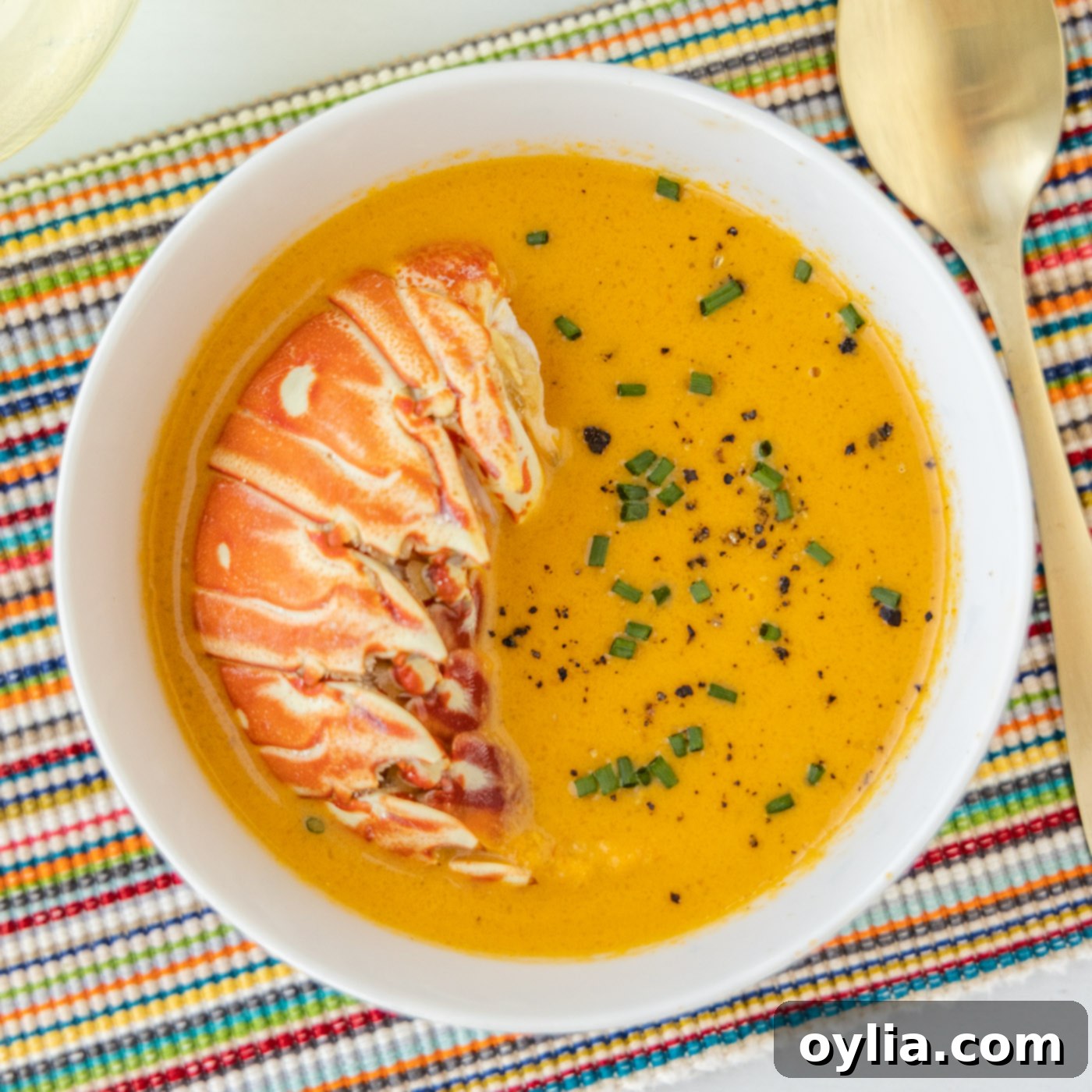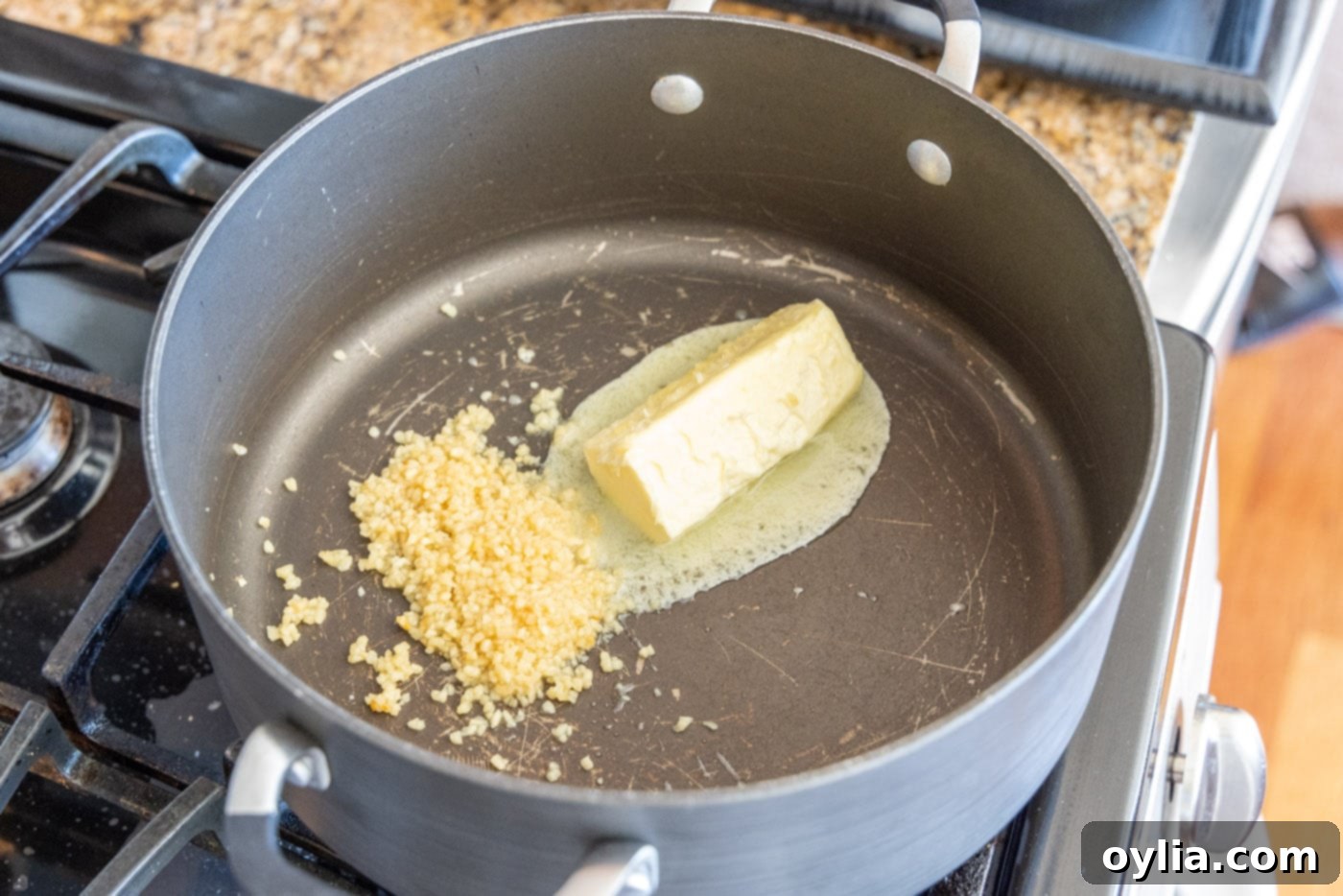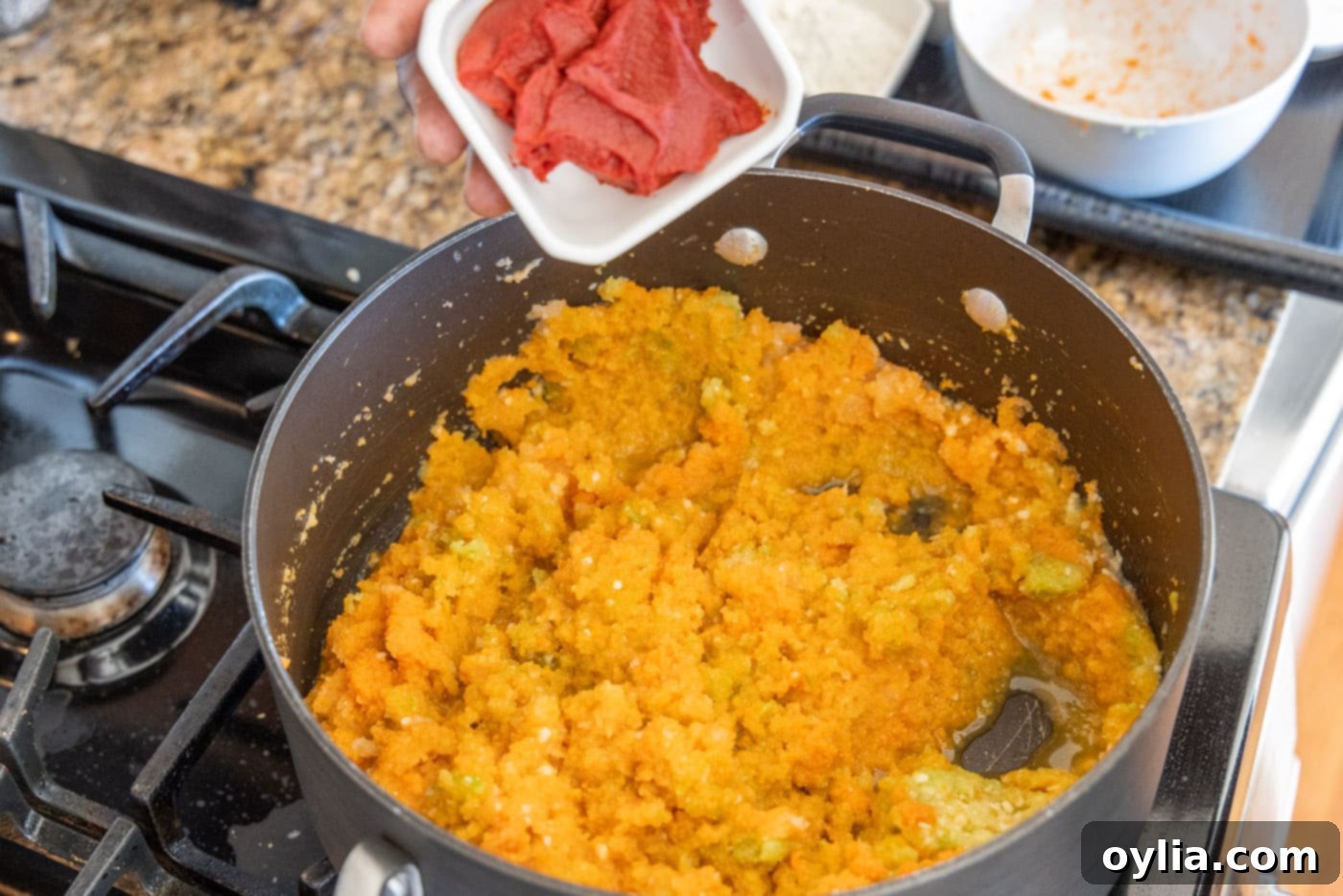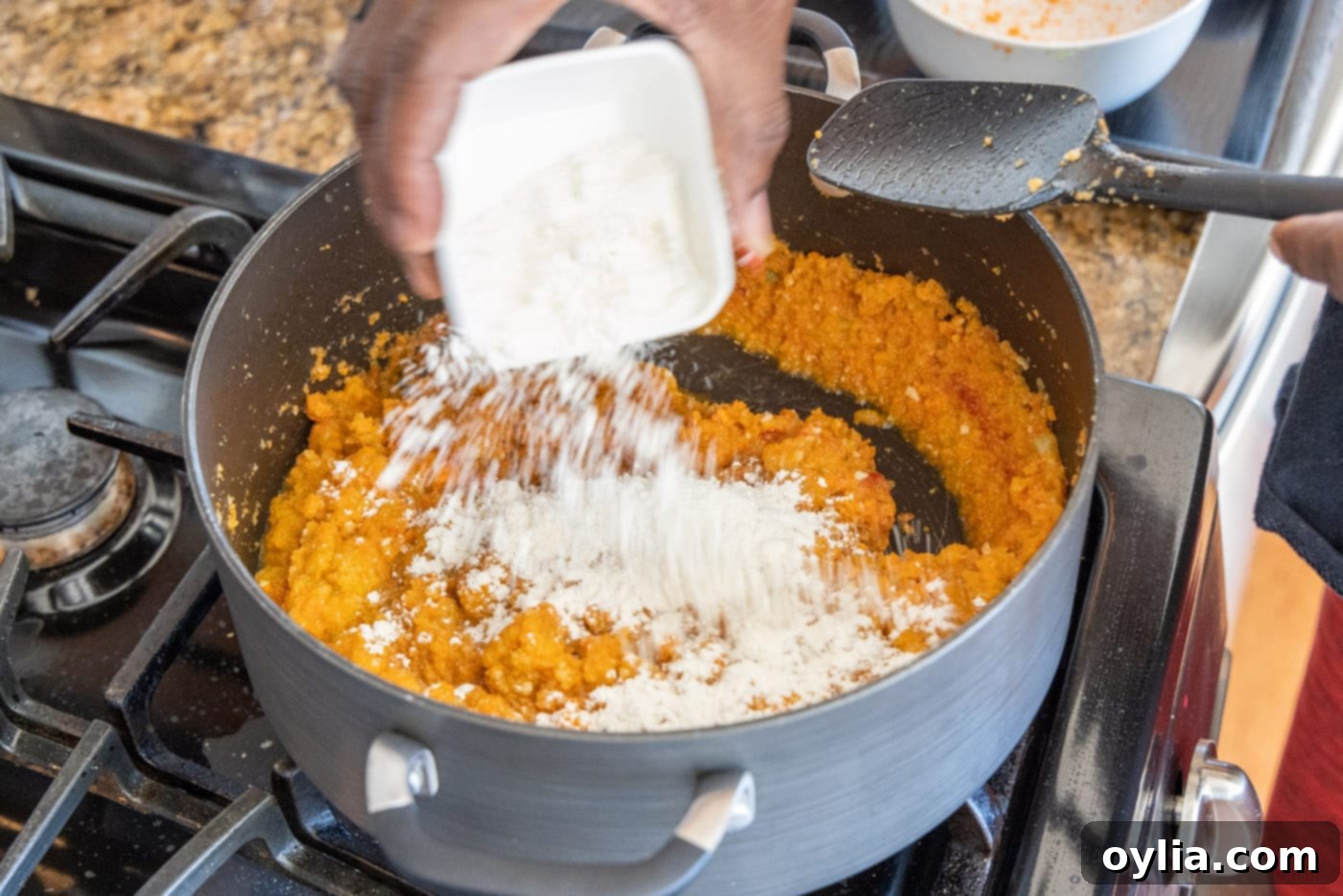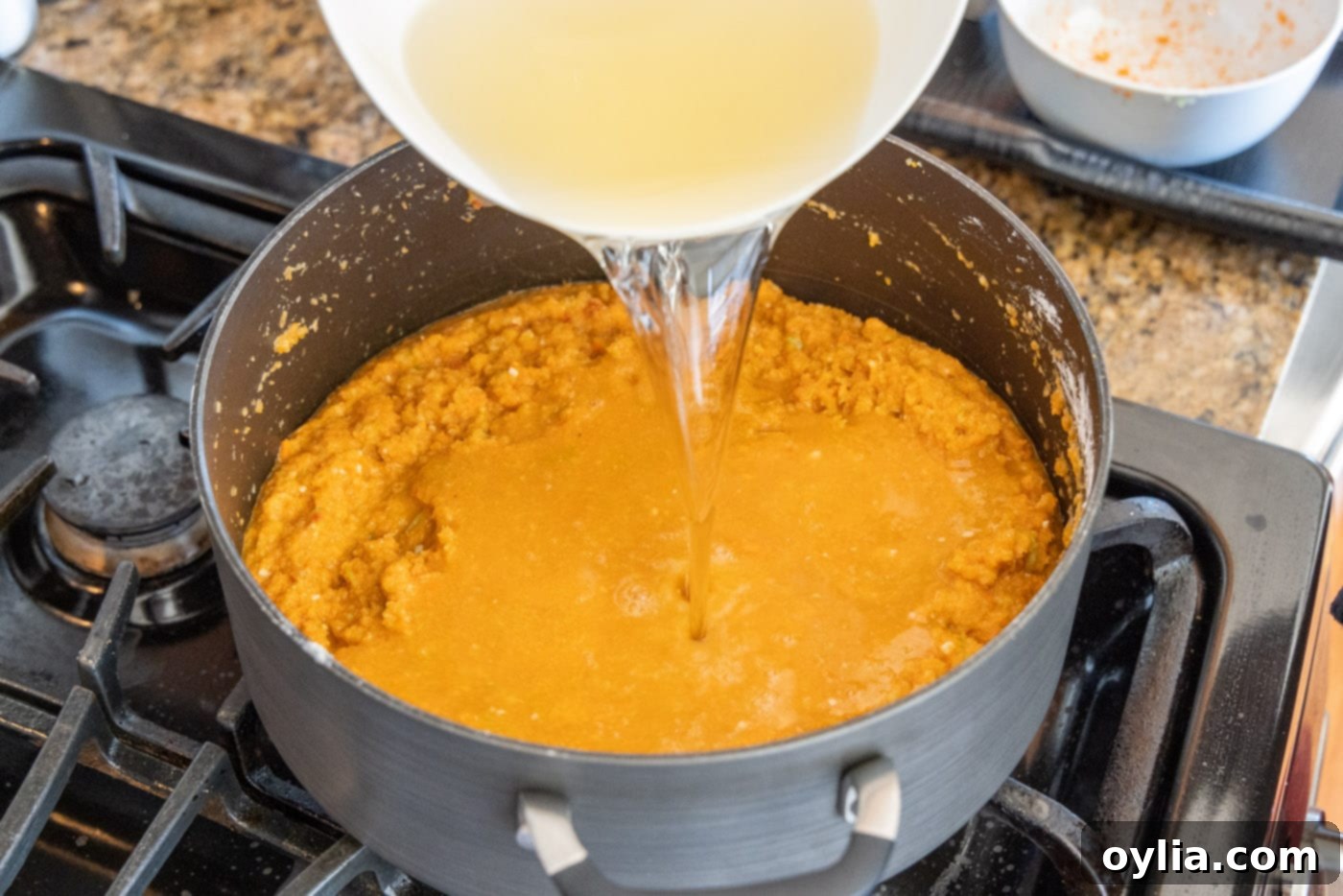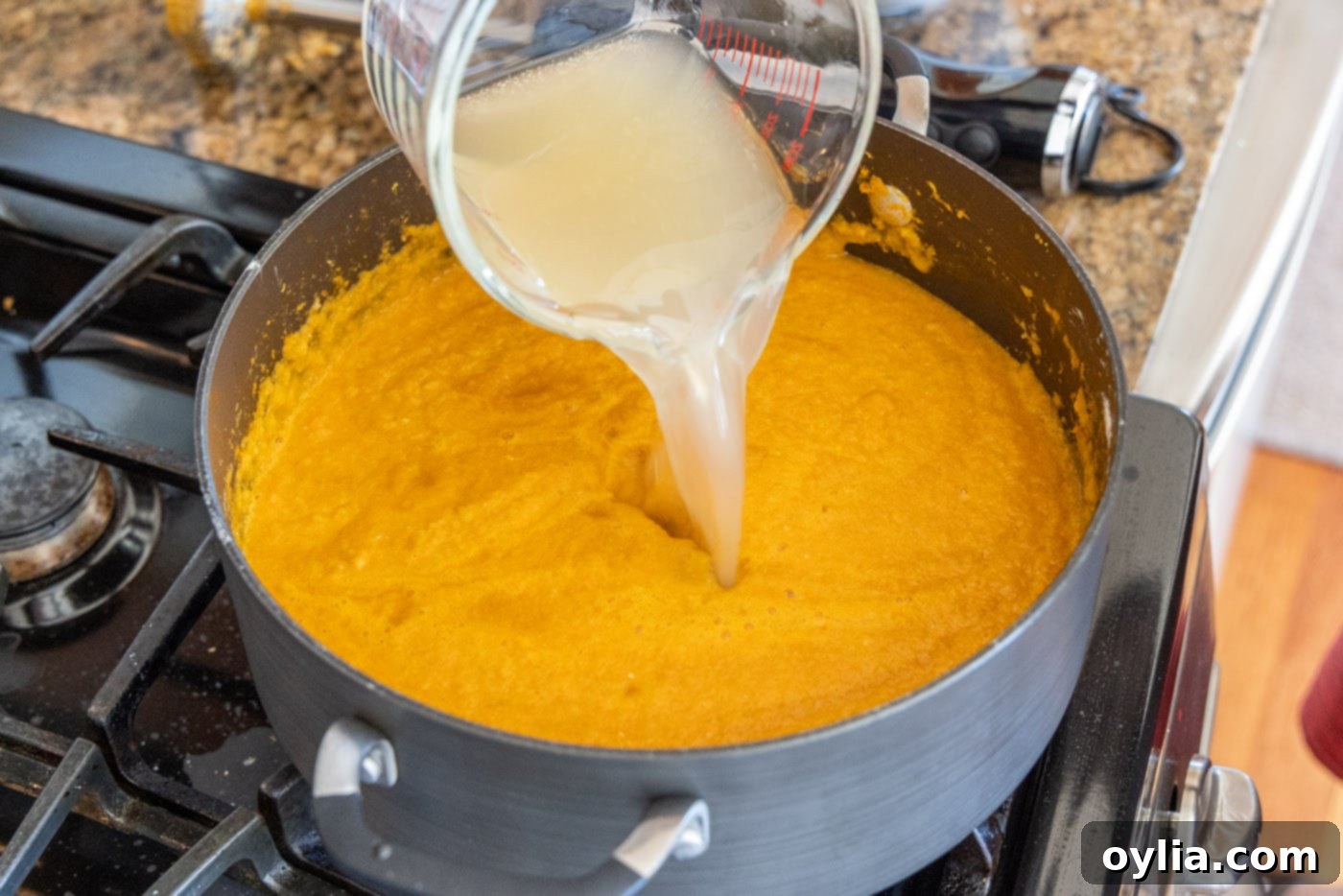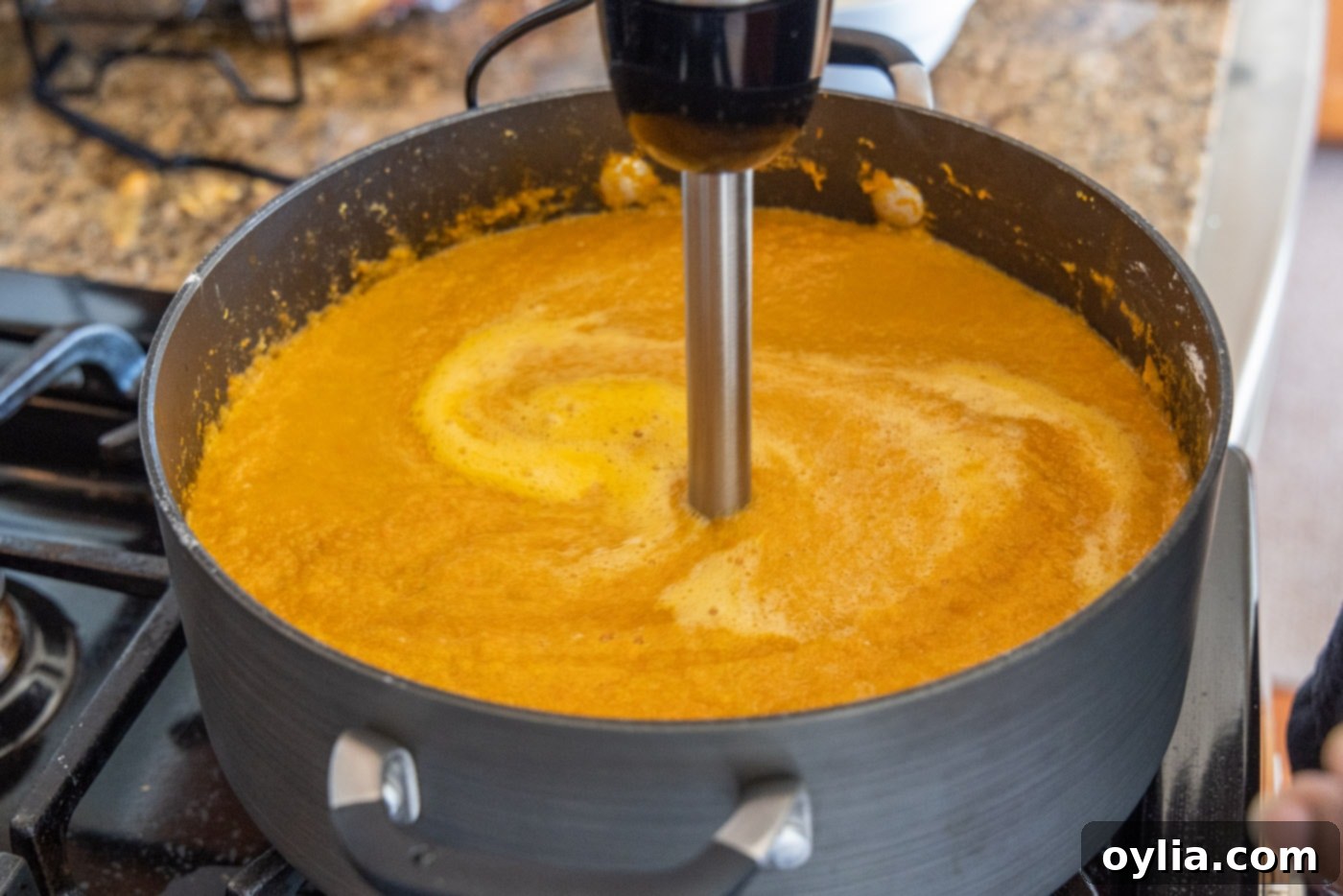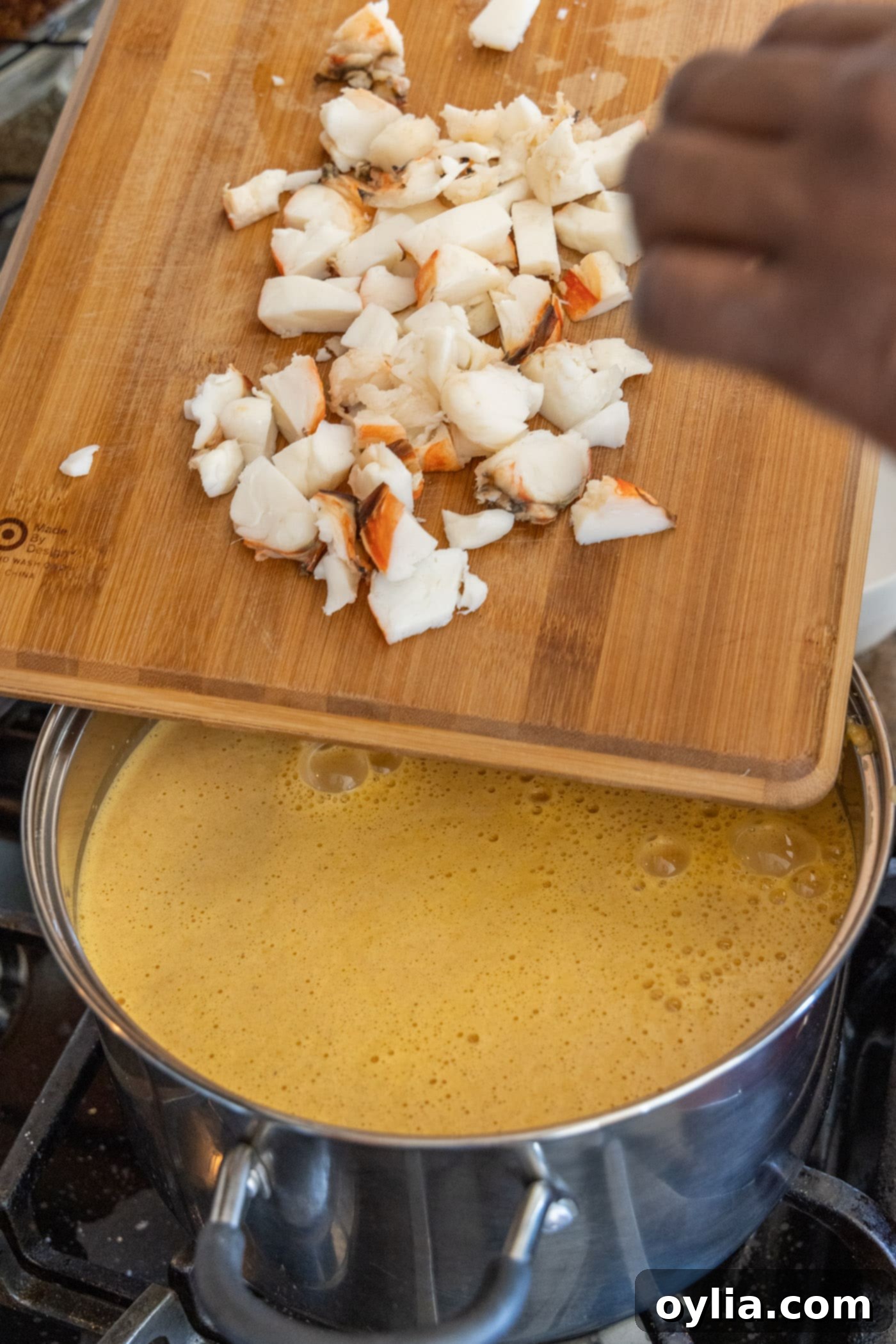Luxurious Homemade Lobster Bisque: A Velvety & Flavorful Seafood Soup Recipe
Indulge in the rich, creamy decadence of a perfectly crafted lobster bisque right in your own kitchen. This exquisite **lobster bisque recipe** delivers a velvety smooth texture and an explosion of flavors, all built upon a luscious base of creamy tomato and white wine. Each spoonful is graced with tender, sweet, and succulent chunks of lobster tails, promising a gourmet experience that is surprisingly simple to achieve. Prepare to impress your guests or treat yourself to a truly special meal with this elegant and satisfying seafood masterpiece.
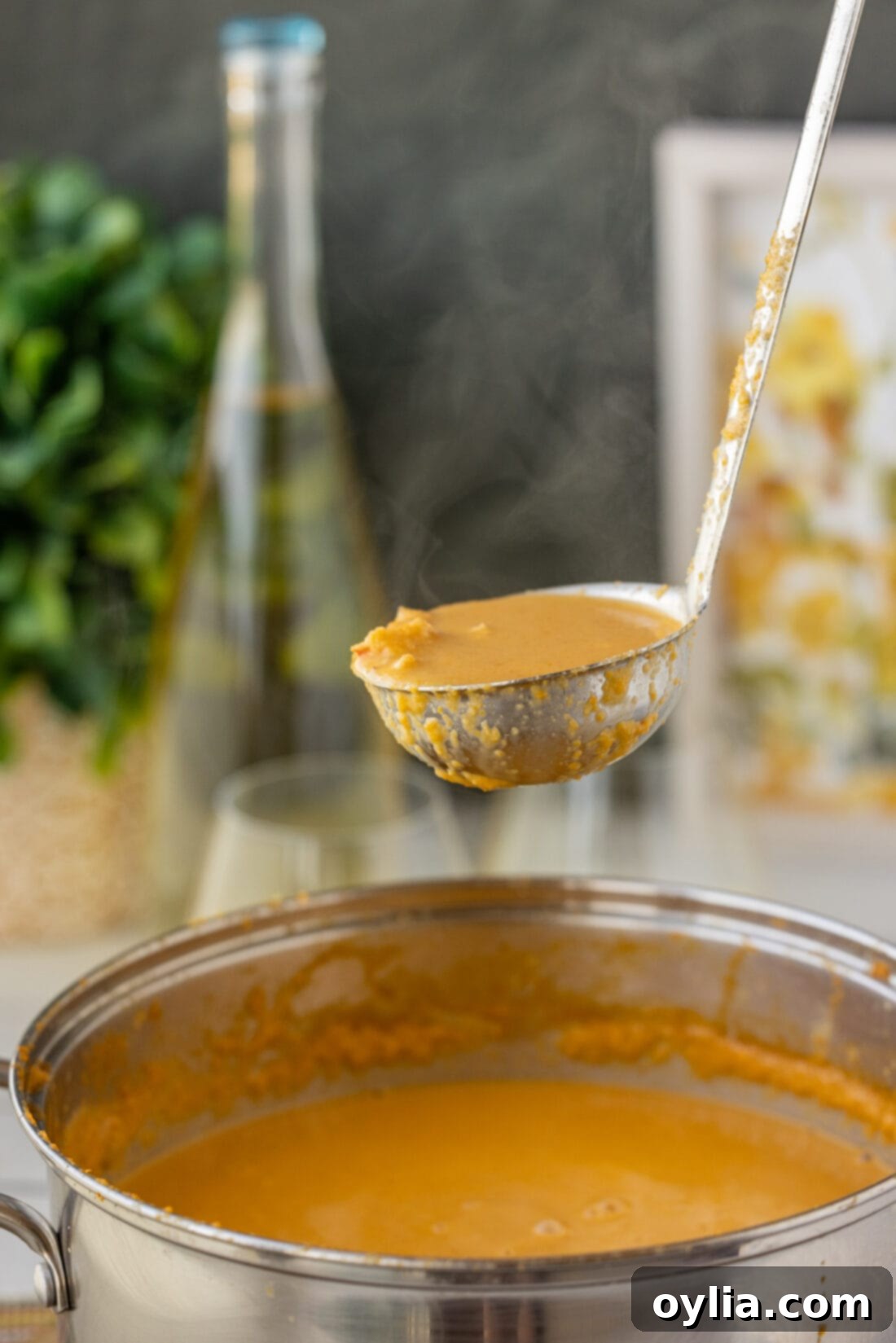
Why This Homemade Lobster Bisque Recipe Works Wonders
This **creamy seafood soup** is a testament to how elegant dining can be accessible. While often perceived as a gourmet starter or a sophisticated entrée reserved for upscale restaurants, making a rich and flavorful lobster bisque at home is surprisingly straightforward. The magic lies in its velvety smooth texture, achieved by a powerful immersion blender that purees all the flavorful aromatics and rich broth into a seamless consistency.
Our **homemade lobster bisque** is infused with a harmonious blend of ingredients, starting with luscious, buttery lobster tails. These are complemented by the aromatic foundation of garlic, onion, celery, and carrots – a classic mirepoix that builds deep flavor. Tomato paste adds a touch of acidity and color, while a dry white wine elevates the seafood notes, creating a complex and balanced profile. Seasoned generously, this recipe ensures every spoonful is bursting with taste. Despite its luxurious appeal, this dish requires minimal prep, making it an ideal choice for dinner parties, special occasions, or simply whenever you crave a truly comforting and indulgent meal. It’s an impressive dish that won’t keep you in the kitchen all day.
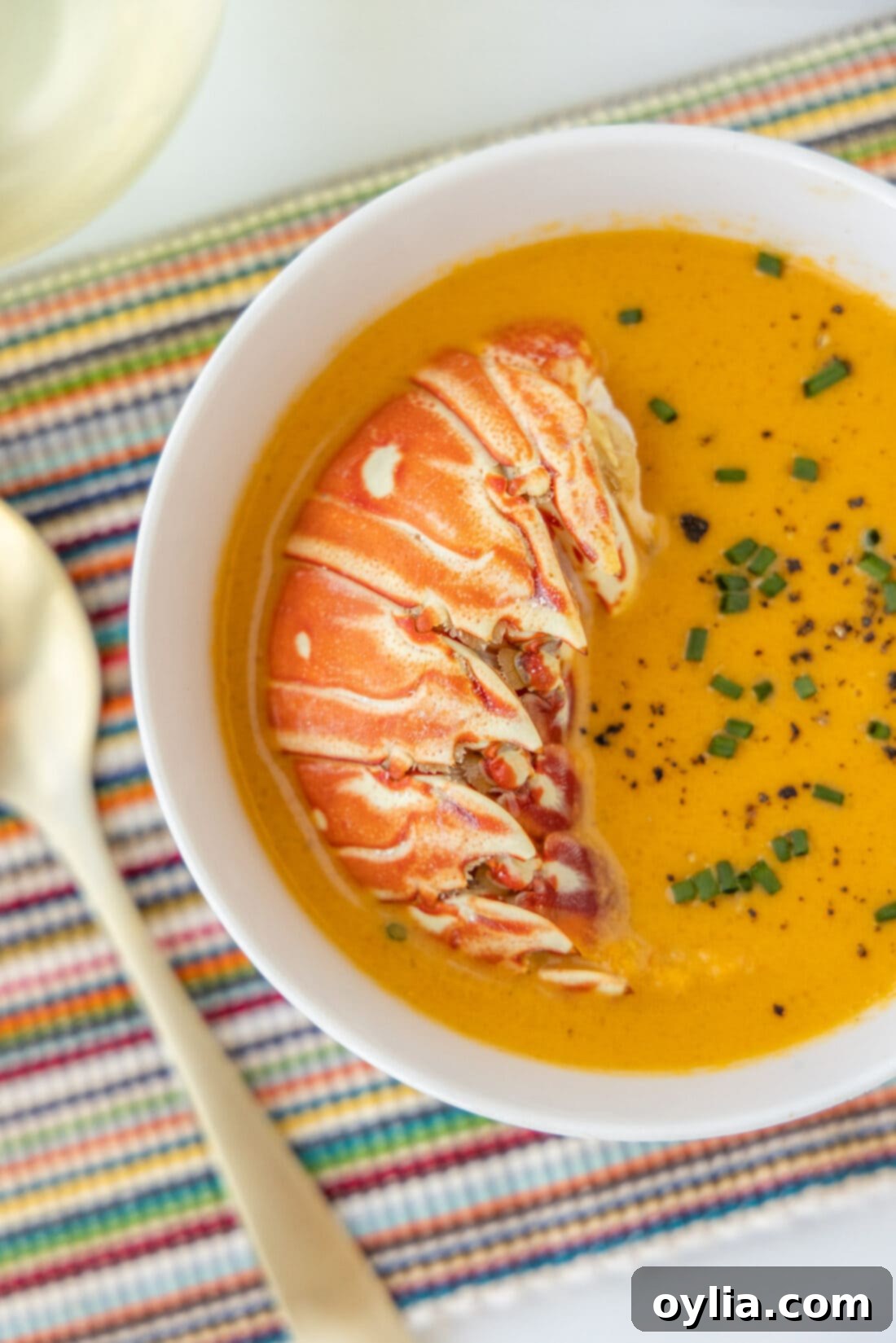
Key Ingredients for Your Perfect Lobster Bisque
Crafting this elegant **lobster bisque** relies on a selection of fresh, high-quality ingredients that come together to create its signature depth and creaminess. From the sweet lobster to the aromatic vegetables and rich dairy, each component plays a crucial role in the final flavor profile. You’ll find all precise measurements, ingredient details, and step-by-step instructions in the comprehensive printable version of this recipe, located at the very end of this post. For now, let’s explore the essential elements that make this bisque truly special.
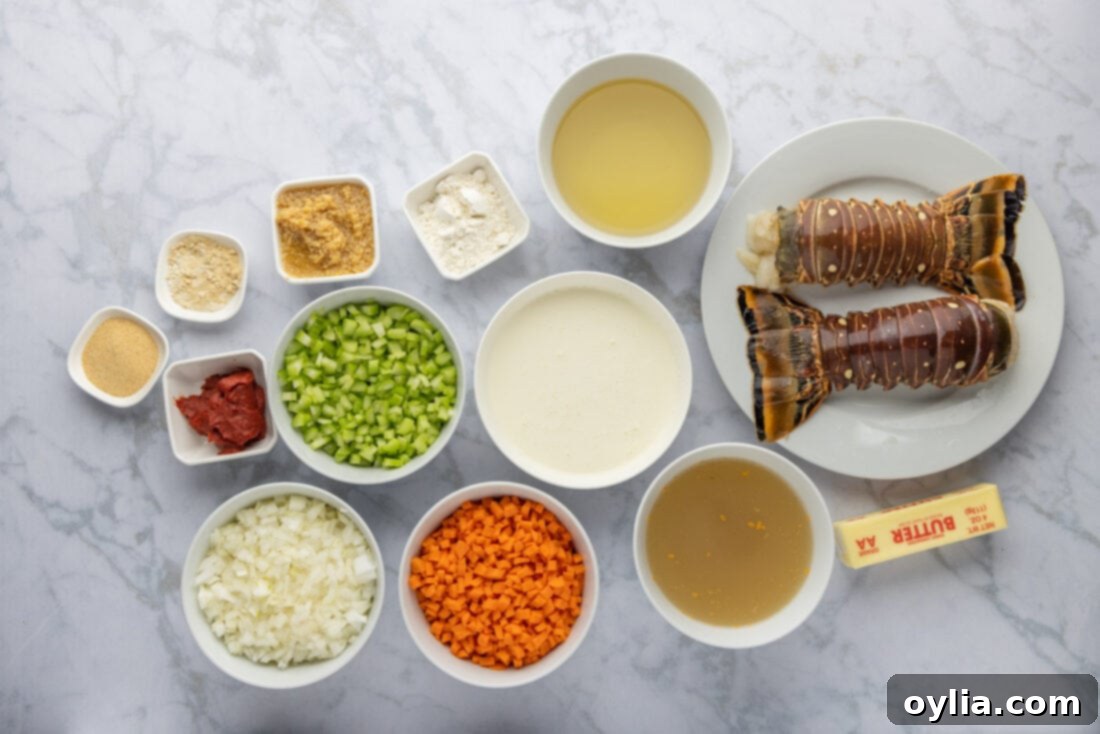
Ingredient Spotlight: Essential Tips & Smart Substitutions for Your Bisque
Understanding each ingredient’s role and knowing possible substitutions can make your **homemade lobster bisque** journey even more enjoyable and adaptable to what you have on hand. Here’s a deeper dive into the key components:
LOBSTER – The star of the show! You’ll start this recipe with pre-cooked lobster tails. For perfectly cooked, tender tails every time, check out our dedicated steamed lobster tail recipe. It guides you through achieving succulent lobster meat in under 30 minutes. While tails are convenient, you can also use meat from whole lobsters, including claws and knuckles, for an even richer flavor, though this will require more prep work to cook and extract the meat.
WINE – Wine is a cornerstone ingredient in authentic bisque, playing a vital role in deglazing the pot and enhancing the delicate flavors of the seafood. A good quality dry white wine is highly recommended. Excellent choices include Pinot Grigio, Chardonnay (unoaked or lightly oaked for subtle notes), or Sauvignon Blanc. These wines offer the necessary acidity without overpowering the lobster. If you prefer to use a different alcohol, brandy can lend a lovely depth, or opt for a dry sherry for a classic touch. For a non-alcoholic alternative, simply substitute with extra seafood stock, chicken stock, or a combination of stock and a splash of white grape juice or lemon juice to mimic some of the acidity.
CREAM – Heavy cream is the secret to the luxurious richness and thickness that defines a classic bisque. It provides that signature velvety mouthfeel. While heavy cream offers the best results, you can substitute it with whole milk if you’re looking for a slightly lighter soup, though the texture will be less opulent. Half-and-half is another good option that falls between whole milk and heavy cream. For a dairy-free alternative, full-fat coconut milk can be used, but be aware that it will impart a subtle coconut flavor, altering the traditional profile.
VEGETABLES – The foundation of flavor in this bisque comes from finely minced onion, celery, and carrots. It’s crucial to mince them finely as this allows them to soften and cook much quicker, ensuring they break down completely into the soup base. This fine chop contributes to the bisque’s smooth texture without the need for excessive blending. For an ultra-smooth consistency without much effort, you can optionally run these vegetables through a food processor to create a puree before sautéing them. This isn’t absolutely necessary, especially with an immersion blender, but it’s an option for those seeking the silkiest possible bisque.
STOCK – Seafood stock is ideal for enhancing the oceanic flavors of the bisque. If high-quality seafood stock is unavailable, you can confidently replace it with vegetable stock or chicken stock. While these alternatives will still create a delicious soup, using seafood stock will yield the most authentic and robust flavor profile. Consider making your own seafood stock from leftover lobster shells (if you’re cooking whole lobsters) for an even deeper flavor.
SEASONINGS – Beyond the primary ingredients, garlic powder and onion powder are essential for rounding out the savory profile. Don’t forget to season generously with salt and freshly ground black pepper to taste, adjusting as needed throughout the cooking process. A pinch of cayenne pepper can also add a subtle warmth if you enjoy a hint of spice.
Crafting Your Culinary Masterpiece: How to Make Lobster Bisque
These step-by-step photos and detailed instructions are here to help you visualize how to make this delightful recipe. For the complete printable version, including all exact measurements and instructions, simply Jump to Recipe at the bottom of this page.
- Prepare the Lobster: Begin by cooking your lobster tails if they aren’t already prepared. Once cooked, allow them to cool slightly, then remove the meat from the shells. Chop the succulent lobster meat into bite-sized pieces and set it aside. This ensures the lobster is ready to be gently warmed at the end, retaining its tenderness.
- Sauté Aromatics: In a sturdy Dutch oven (which retains heat wonderfully for soups), melt the unsalted butter over medium heat. Add the minced garlic and sauté until fragrant, being careful not to brown or burn it, which can make it bitter. This step builds the first layer of aromatic flavor for your bisque.

- Add Vegetables: Incorporate the finely minced onion, celery, and carrots into the Dutch oven. Stir well to combine them with the butter and garlic. Continue to sauté for several minutes until the vegetables have softened significantly. This process allows them to release their sweet and savory flavors into the base of the soup.
- Stir in Tomato Paste: Add the tomato paste to the sautéed vegetables. Stir constantly for 1-2 minutes, allowing the tomato paste to cook slightly and deepen in color. This step is crucial for developing its rich, concentrated flavor and removing any raw taste.

- Create a Roux: Sprinkle the all-purpose flour evenly over the vegetable mixture. Stir continuously for another 1-2 minutes. The flour will absorb the butter and create a thick paste, known as a roux. This roux acts as a thickening agent for the bisque, ensuring a smooth, luscious consistency.

- Deglaze with Wine & Season: Pour in the dry white wine, garlic powder, and onion powder. Stir vigorously, scraping the bottom of the Dutch oven to release any browned bits of flavor (this is called deglazing). Allow the wine to simmer for a few minutes until it has reduced slightly and the alcohol has cooked off. This step adds a crucial layer of acidity and complexity.

- Add Liquids & Blend Smooth: Pour in the seafood stock and the heavy cream. Stir everything together. Now, use an immersion blender directly in the pot to blend the mixture until it is completely smooth and creamy. This is where your bisque gets its signature silky texture, incorporating all the cooked vegetables and flavors into a homogenous soup. Continue blending until no discernible chunks remain.


- Simmer for Flavor Development: Reduce the heat to low and allow the bisque to simmer gently, uncovered, for about 5 minutes. This simmering time allows the flavors to meld and deepen, creating a more cohesive and delicious soup.
- Optional Straining for Ultra-Smoothness: For an exceptionally smooth, restaurant-quality bisque, you can optionally strain the soup through a fine-mesh sieve at this point. This step will remove any remaining fibrous vegetable bits or tiny particles, resulting in an incredibly silky consistency. However, be aware that straining will reduce the overall volume of your soup slightly as some solids are removed. Add the strained bisque back to the pot.
EXPERT TIP – While straining offers a silkier texture, it’s absolutely fine to skip this step! Leaving the bisque as-is preserves all the nutrients from the vegetables and still yields a wonderfully creamy soup. Only strain if you’re truly aiming for that pristine, unblemished consistency.
- Final Lobster Integration: Add the chopped lobster meat to the soup in the pan. Stir gently and heat through for only 1-2 minutes, stirring occasionally. The goal is just to warm the lobster, not to cook it further, which could make it tough. This final step ensures the lobster remains tender and flavorful.

Frequently Asked Questions & Expert Tips for Lobster Bisque
Absolutely! While the dry white wine is a staple ingredient in classic lobster bisque, adding a layer of depth and acidity that highlights the seafood, it’s entirely possible to make a delicious version without alcohol. Simply substitute the wine with an equal amount of additional seafood stock, vegetable stock, or chicken stock. For a hint of that bright, acidic note typically provided by wine, you can also add a small splash of white grape juice or a squeeze of fresh lemon juice at the end, adjusting to your taste.
To properly store leftover lobster bisque, first ensure it has fully cooled to room temperature. Transfer the bisque into an airtight container and store it in the refrigerator for 1-2 days. For longer storage, bisque can be frozen for up to 2-3 months. When freezing, it’s best to freeze the bisque without the added lobster meat, as lobster can become slightly tougher when frozen and reheated. Thaw overnight in the refrigerator, then gently reheat on the stovetop over low heat, stirring frequently. Add fresh lobster meat (if desired) and a splash of milk or cream to restore consistency if it has thickened too much.
Yes, you absolutely can! Using fresh or live lobster can add even more depth of flavor to your bisque, especially if you create a stock from the shells. However, this will increase your preparation time. You would need to cook and clean the whole lobster, saving the shells to simmer for a homemade stock. Then, follow the recipe using the freshly cooked meat and your homemade stock. The richer flavor is often worth the extra effort for true lobster aficionados.
The main differences lie in texture and consistency. Lobster bisque is typically a smooth, creamy, and intensely flavored soup, often thickened with rice, a roux, or puréed vegetables, and then strained for a velvety finish. It emphasizes the luxurious, refined taste of lobster. Lobster chowder, on the other hand, is a heartier, chunkier soup that often contains pieces of potato, corn, or other vegetables, and larger pieces of lobster meat. It has a thicker, rustic consistency, but is not puréed and strained like a bisque.
Yes, bisque is an excellent soup to prepare in advance! You can make the entire soup base (up to the point of adding the lobster meat) a day or two ahead of time. Store it in an airtight container in the refrigerator. When ready to serve, gently reheat the bisque on the stovetop over low heat. Once warmed through, stir in the cooked lobster pieces and heat for just a minute or two until the lobster is warm. This method ensures the lobster remains perfectly tender and the soup’s flavors have had even more time to meld beautifully.
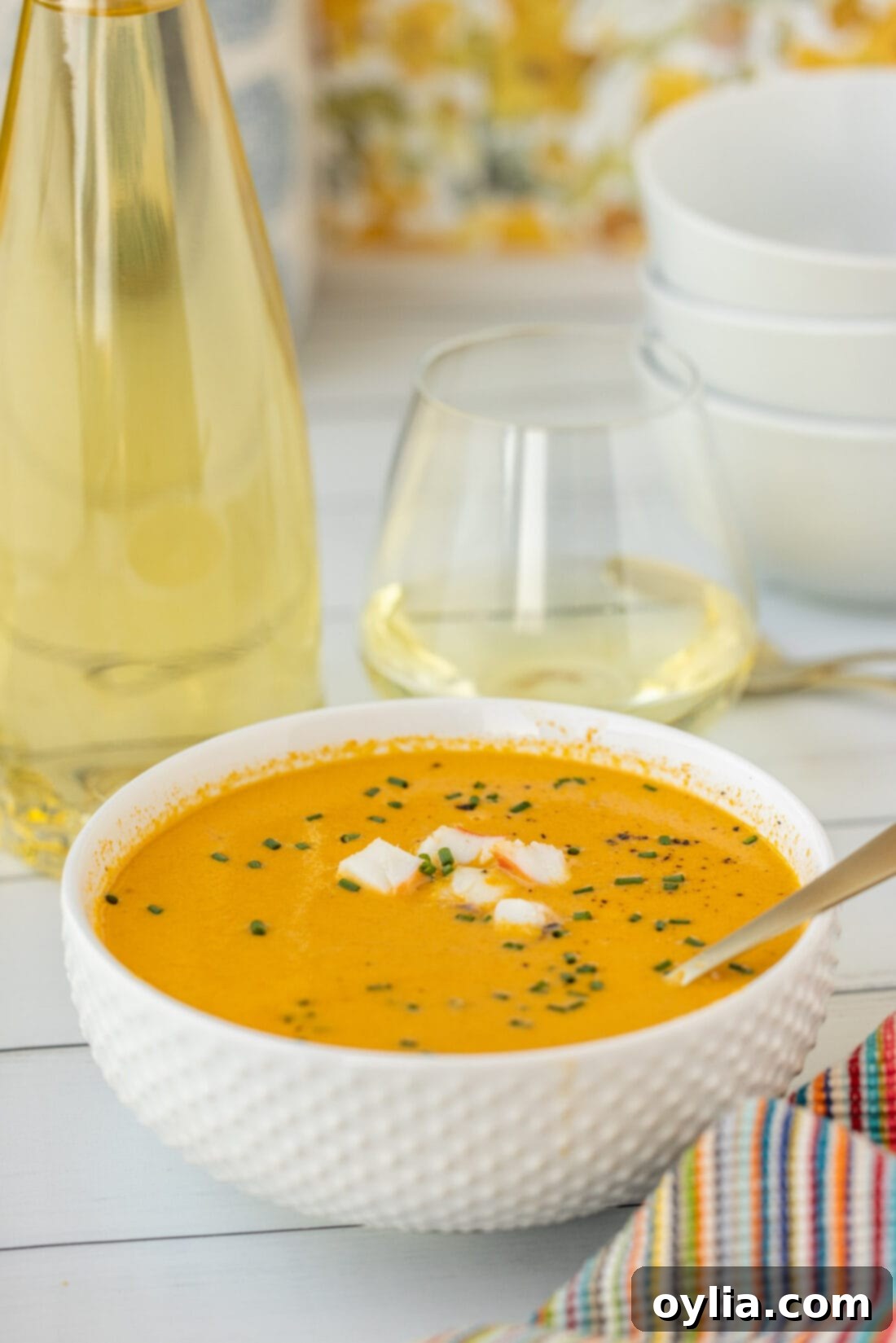
Elevate Your Meal: Serving Suggestions for Lobster Bisque
Lobster bisque is incredibly versatile and can be adapted to suit various dining occasions. It makes the perfect elegant appetizer, setting a luxurious tone before a more elaborate main course. Its rich flavor and creamy texture also allow it to stand proudly as a sophisticated main course, particularly for a lighter yet indulgent meal. To enhance the experience, consider these serving suggestions:
- Garnishings: A sprinkle of fresh chopped chives, parsley, or dill adds a pop of color and fresh herbaceous notes. A swirl of extra heavy cream or a drizzle of good quality olive oil can also add visual appeal and an extra layer of richness. A dash of paprika or a few turns of freshly ground black pepper can provide a subtle finishing touch.
- Accompaniments: Serve alongside crisp oyster crackers, which offer a delightful textural contrast, or with slices of warm, crusty bread (like a baguette) perfect for soaking up every last drop of the decadent soup. Garlic bread or cheese bread can also be wonderful pairings.
- Meal Pairings: If serving as a main course, pair your bisque with a light, refreshing green salad dressed with a vinaigrette to balance the richness. For a complete gourmet meal, a crisp, dry white wine such as a Sauvignon Blanc or an unoaked Chardonnay would complement the flavors beautifully.
Discover More Delicious Lobster Recipes
If you’ve fallen in love with the exquisite taste of lobster, you’re in luck! There are countless ways to enjoy this magnificent seafood. Explore these other fantastic lobster recipes that are sure to delight your palate and impress your guests:
- Classic Lobster Roll: A New England favorite, packed with tender lobster meat.
- Creamy Lobster Risotto: An indulgent and sophisticated dish.
- Perfectly Steamed Lobster Tail: Simple, elegant, and showcases the lobster’s natural sweetness.
- Decadent Lobster Mac and Cheese: The ultimate comfort food with a gourmet twist.
I absolutely adore spending time in the kitchen, experimenting with new flavors and classic dishes, and then sharing my culinary adventures with all of you! Keeping up with new recipes daily can be tricky, which is why I offer a super convenient newsletter every time a fresh recipe is posted. Simply subscribe today and start receiving your free daily recipes straight to your inbox – never miss a delicious creation!

Lobster Bisque: A Creamy & Flavorful Seafood Soup
IMPORTANT – There are often Frequently Asked Questions within the blog post that you may find helpful. Simply scroll back up to read them!
Print It
Pin It
Rate It
Save It
Saved!
Course: Appetizer, Dinner
Cuisine: American, French
Ingredients
- 1 pound lobster tails 2 large tails, cooked
- ½ cup unsalted butter
- ¼ cup minced garlic
- 1 ½ cups finely minced onion
- 1 ½ cups finely minced celery
- 1 ½ cups finely minced carrot
- 2 Tablespoons tomato paste
- 3 Tablespoons all purpose flour
- 1 ½ cups dry white wine such as Pinot Grigio
- 1 Tablespoon garlic powder
- 1 Tablespoon onion powder
- 1 ½ cups seafood stock
- 2 cups heavy whipping cream
Things You’ll Need
-
immersion blender
-
Dutch oven
-
Vinyl gloves
Before You Begin: Important Tips for the Best Bisque
- Vegetable Preparation: For a wonderfully smooth bisque, ensure your onion, celery, and carrots are very finely minced. This not only helps them soften and cook faster but also ensures they blend seamlessly into the soup without leaving large chunks. If you desire an ultra-silky consistency, feel free to run the vegetables through a food processor to create a purée before sautéing.
- Wine Selection: The choice of wine greatly influences the bisque’s flavor. We recommend a good quality dry white wine such as Pinot Grigio, Chardonnay (preferably unoaked), or Sauvignon Blanc. These options provide the ideal balance of acidity and fruit notes to complement the lobster. For an alternative, brandy can add a deeper, warmer flavor, or a dry sherry will lend a more traditional and complex aroma.
- Stock Alternatives: Seafood stock is paramount for the most authentic and robust lobster flavor. However, if it’s not readily available, you can successfully substitute it with a good quality vegetable stock or chicken stock. Keep in mind that while delicious, these alternatives will result in a slightly different flavor profile than a true seafood-based stock.
- Serving Size Note: If you choose not to strain your bisque through a fine-mesh sieve, you will retain more volume and likely yield closer to 8 servings from this recipe, as no solids will be removed.
Instructions
-
Cook lobster tails until done, then carefully remove the meat and chop it into bite-sized pieces. Set the prepared lobster meat aside; it will be added near the end of the cooking process to ensure it stays tender.
-
In a durable Dutch oven, melt the unsalted butter over medium heat. Once melted, add the minced garlic and sauté for about 1 minute until fragrant, taking care not to burn it.
-
Add the finely minced onion, celery, and carrots to the Dutch oven. Stir well to combine them with the butter and garlic, then continue to sauté for 5-7 minutes, or until the vegetables have softened.
-
Stir in the tomato paste, cooking for another 1-2 minutes while stirring constantly. This step helps to intensify the tomato flavor and color.
-
Sprinkle the all-purpose flour over the vegetable mixture and stir continuously for 1-2 minutes to create a roux, ensuring all the flour is fully incorporated and cooked to remove any raw flour taste.
-
Pour in the dry white wine, along with the garlic powder and onion powder. Stir vigorously, scraping the bottom of the pot to release any flavorful browned bits. Allow the mixture to simmer for a few minutes until the wine has reduced slightly and the alcohol has evaporated.
-
Add the seafood stock and heavy cream to the pot. Using an immersion blender, carefully blend the mixture directly in the Dutch oven until it is completely smooth and all vegetables are puréed into the soup, creating a rich and velvety bisque base.
-
At this stage, you have the option to strain the bisque through a fine-mesh sieve if you desire an exceptionally smooth, restaurant-quality consistency. This step removes any remaining fibrous particles, resulting in a silkier soup. If you choose to strain, add the strained bisque back to the pot.
Remember, leaving the bisque unstrained is perfectly acceptable and will result in a delicious, creamy soup with all its nutrients intact. Only strain if a pristine, silky texture is your top priority.
-
Reduce the heat to low and allow the bisque to simmer gently, uncovered, for an additional 5 minutes. This simmering time allows the flavors to fully meld and deepen.
-
Finally, add the chopped lobster meat to the warm bisque in the pan. Stir occasionally and heat through for only about 1-2 minutes, just enough to warm the lobster without overcooking it, ensuring it remains tender and flavorful. Serve immediately and enjoy!
Nutrition Information
Tried this Recipe? Pin it for Later!Follow on Pinterest @AmandasCookin or tag #AmandasCookin!
The recipes on this blog are tested with a conventional gas oven and gas stovetop. It’s important to note that some ovens, especially as they age, can cook and bake inconsistently. Using an inexpensive oven thermometer can assure you that your oven is truly heating to the proper temperature. If you use a toaster oven or countertop oven, please keep in mind that they may not distribute heat the same as a conventional full sized oven and you may need to adjust your cooking/baking times. In the case of recipes made with a pressure cooker, air fryer, slow cooker, or other appliance, a link to the appliances we use is listed within each respective recipe. For baking recipes where measurements are given by weight, please note that results may not be the same if cups are used instead, and we can’t guarantee success with that method.
